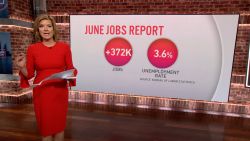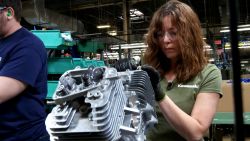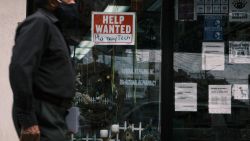Editor’s Note: A version of this story appeared in CNN’s Work Transformed newsletter. To get it in your inbox, sign up for free here
It’s pushing 1:00 a.m. as I write this.
For the past few months, my most productive work hours are between 9 p.m. and 1:00 a.m. During the day, I’m chasing after my two young kids while sneaking in bits of work.
I know I am not alone.
My colleague Jeanne Sahadi wrote about the demands working parents face right now trying to be a full-time employee, caretaker, camp counselor and educator with so many schools and camps shuttered because of Covid-19.
The crazy hours and insane multitasking works for a short period of time. But it’s not sustainable. The well will run dry.
With the possibility of continued school closures in the fall, working parents are going to have to make some tough decisions, including leaving the workforce – if they can afford to.
No company wants to lose good workers, which is why many are trying to come up with ways to help parents. Whether it’s more flexible schedules, increased paid and unpaid leave, job sharing or continued remote work when offices re-open, companies are looking for ways to avoid a talent drain.
But will that be enough? Read the full story here.
Is this the end of the office?
For some companies, the transition to working remotely during the pandemic has gone so well they plan to let employees work from home permanently.
So does that mean this is the end of the office?
Not quite.
But it could mean we’ll see fewer of those massive open-spaced headquarters adorned with flashy perks like rock climbing walls or onsite dry cleaners.
I recently spoke to the CEO of artificial intelligence company Interactions, who was about to sign a lease on a 53,000-square-foot office space in March, but decided against it at the last minute.
Before the pandemic, about one-third of his 475 team members were working remotely. Now everyone is working from home, with plans to keep it that way.
The company’s new headquarters will now be about 9,000 square feet and will mainly be used to bring in customers and hold occasional team meetings. It will no longer be an everyday workday destination for employees.
But not everyone wants to continue remote work life.
“There are a lot of people sitting at home for the last few months absolutely dying to get out of the house and back into an office,” Domm Holland, CEO of e-commerce checkout company Fast, told me.
He said he will return to the office, but added that flexibility is important when it comes to where employees work.
Technology made it easy for us to transition to working remotely, but it doesn’t fully replace the in-person interaction that many workers crave.
Check out my full story on the future of the office.
No more snack jars
Speaking of changes coming to the office, we are starting to get a glimpse of what our workspaces will look like when we return.
Remember those little comforts around the office that made it more tolerable?
Maybe it was the co-worker who you could always count on to have a filled candy jar. The knick-knacks you brought back from each vacation and placed on your desk to remind you why you work so hard. Or those walks to the kitchen to catch up on life with a colleague while getting a cup of coffee.
They probably won’t be around anymore.
In her in-depth report on Salesforce.com’s reopening plans, New York Times reporter Natasha Singer details what life might look like for employees.
No more hugging. No more shared snack jars. Instead, there will be health surveys, temperature checks and more bare desks.
“It’s going to be different,” said Salesforce’s chief executive, Marc Benioff, according to the New York Times. “It’ll be more sterile. It’ll be more hospital-like.”
To read more about Salesforce’s pandemic management playbook click here.
What’s going on with the housing market?
In the early months of the pandemic, the housing market slowed significantly.
But buyers are now coming back and they’re looking for homes, reports CNN Business’ Paul LaMonica.
But not everyone is going to be able to participate.
Realtors across the country are saying there are not enough homes for sale compared to the number of buyers in the marketplace.
For first-time homebuyers, the market looks especially tough, writes Lawrence Yun, chief economist and senior vice president of research at the National Association of Realtors, for CNN Business’ Perspectives.
Another major hurdle for this group is being able to afford a down payment.
There’s a big difference in homeownership rates due to race, age and income, notes Yun. To boost ownership rates among these prospective buyers, he suggests a down payment assistance program or homebuyer tax credit could help.
For renters, there’s an opportunity to upgrade, especially in cities. Say hello to “pandemic pricing,” with rents falling across the US and landlords offering enticing incentives, like a free month of rent.
The top four most expensive cities – San Francisco, New York, Boston and San Jose – all saw median rents on one-bedroom apartments decline from a year ago, reports CNN Business’ Anna Bahney.
Coffee break
Alright all you working parents, listen up. It’s time for a little self care.
I fully expect a major eye roll at the suggestion. We’re in the middle of a pandemic – work is demanding, children are even more so, dishes are piling up and even grocery shopping has become a whole thing.
Trust me. I get it.
But hear me out: Self care is always important for your health. But it’s even more important right now.
If you’ve let chronic stress build up, you’re at risk of burning out, Vaile Wright, the senior director for health care innovation at the American Psychological Association, told CNN’s Kristen Rogers. And with burnout, you can start to lack empathy – which is important for raising kids.
So here are six ways to give yourself a little break amid all the chaos.





















